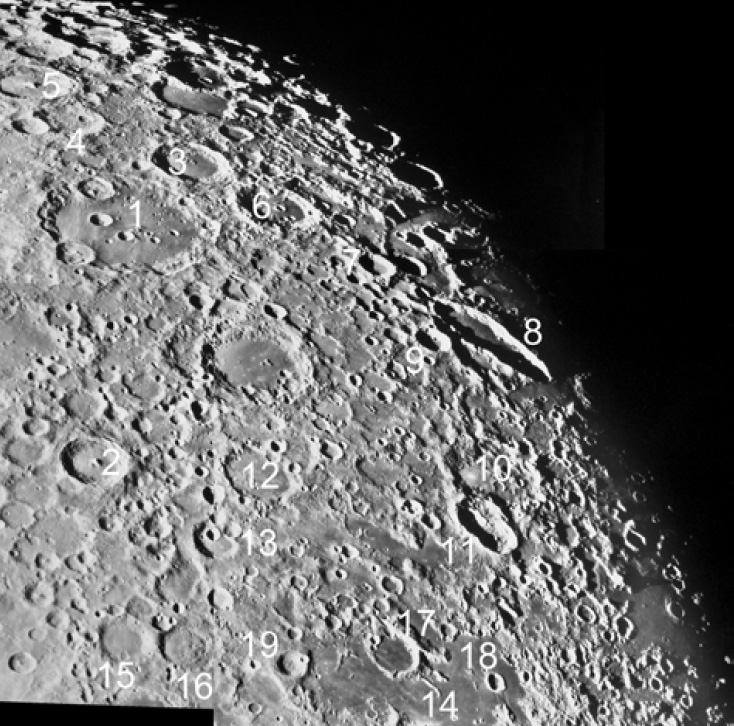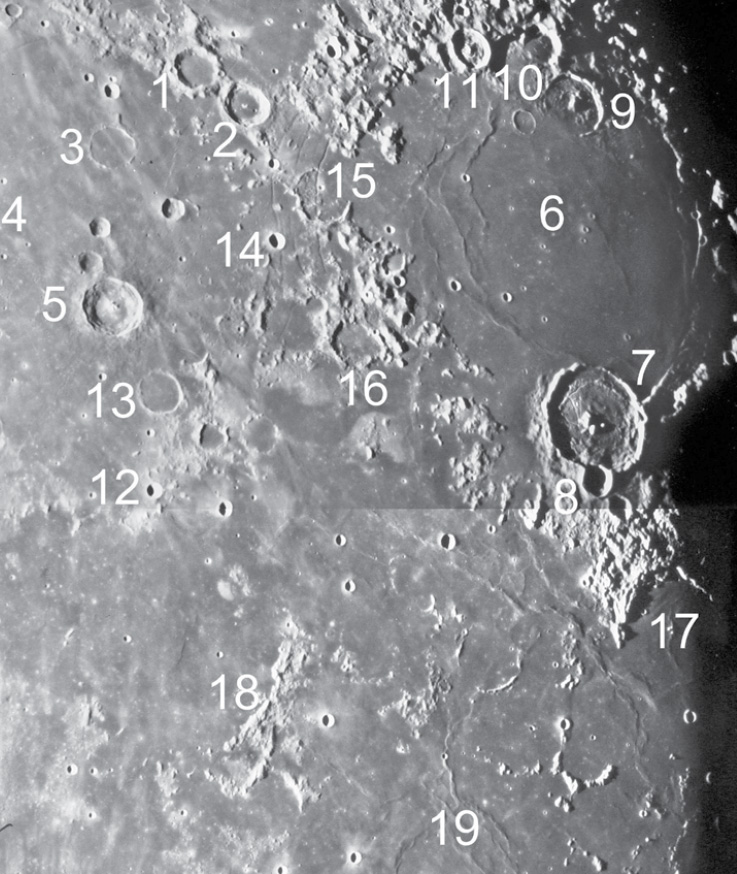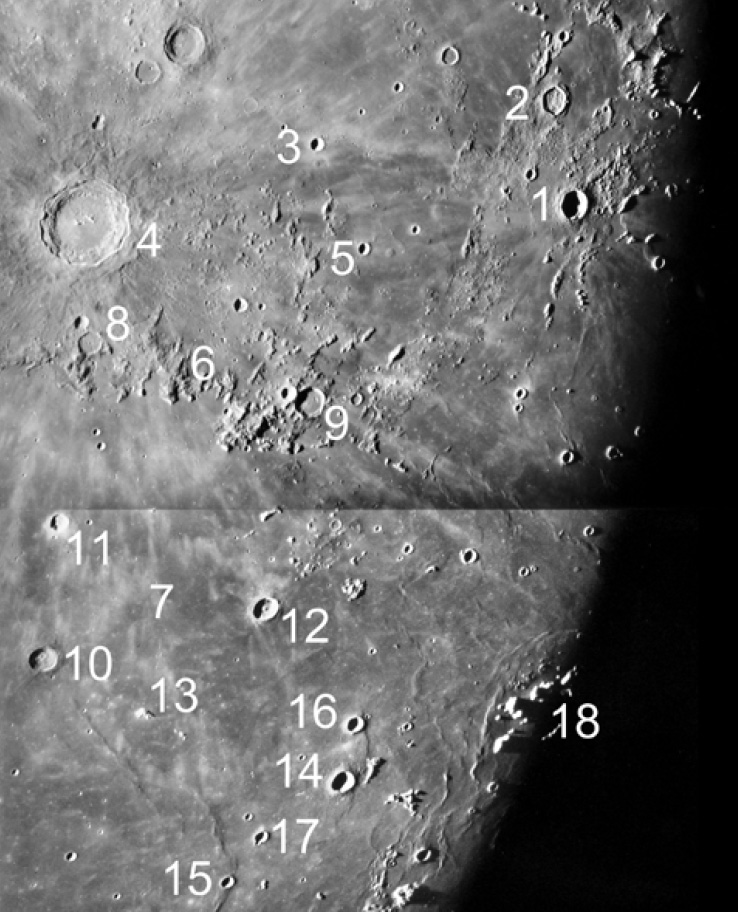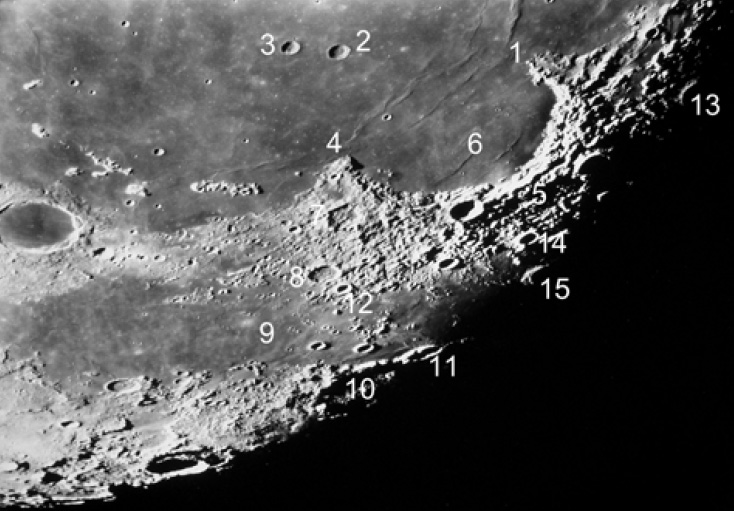Following the Terminator Part 6
By Joseph Cohen
First published Crux Feb - Mar 2008
Day 9-10
This phase of the moon gives extensive exposure to the east portion of the North Polar area, the early western area of Oceanus Procellarum and the structures around M. Humorum as the terminator moves to the west. Some ridges, rays and dark areas are seen and useful guidelines are given to explore some difficult regions. The dark ring around Tycho separating it from its corona and its rays are becoming apparent and will continue to develop over the coming days as will the ray systems from Copernicus and Kepler that will be discussed at day 14. However some use will be made of the rays to help in identifying other structures.
Southern Hemisphere Turning to the South Pole area, identify the large square CLAVIUS (Fig. 1, 1) with the curved series of craterlets crossing its floor.

Figure 1:
Southern limb of the Moon on Day 9-10.
1 Clavius 2 Tycho 3 Blancanus 4 Gruemberger 5 Moretus 6 Scheiner 7 Rost 8 Schiller 9 Bayer 10 Mee 11 Hainzel
12 Wilhelm 13 Heinsius 14 Palus Epidemiarum 15 Gauricus 16 Wurzelbauer 17 Capuanus 18 Ramsden 19 Cichus
Images from the Consolidated Lunar Atlas maintained by the Lunar and Planetary Institute. South is to the top.
The ‘Southern Cross’s` north south axis passes from TYCHO (Fig. 1, 2) through the centre of Clavius into the gutter that separates BLANCANUS (Fig. 1, 3) to the west and GRUEMBERGER (Fig. 1, 4) to the east. South and slightly east of Gruemberger we meet MORETUS (Fig. 1, 5) with its central mountain. A west meridian reference line from this crater crosses the square Blancanus with tiny craterlets and hills near its south east flooded floor. The crater almost touches Clavius’ south west corner. Its western twin SCHEINER (Fig. 1, 6) with three obvious craterlets in its northwest flooded floor is in the same meridian and almost touches the last crater. The meridian reference line also passes through the small ROST (Fig. 1, 7), the largest of a cluster of small craters to point to the large elongated SCHILLER (Fig. 1, 8), whose north end is narrower than the rest of the crater where a short narrow ridge may be seen in its floor, if it is not in shadow. The cluster of small craters north of Rost ends at its largest member BAYER (Fig. 1, 9), east of Schiller. North of Schiller and at the same distance between it and Scheiner, a north line crosses the larger MEE (Fig. 1, 10) that is usually poorly defined, but whose east and west walls are visible tonight with a dark floor hiding several craterlets and hills. It touches the smaller HAINZEL (Fig. 1, 11) to its north that is really a triple crater but appears as a double. The two previous craters lie on a west line from Tycho that crosses the large flooded WILHELM (Fig. 1, 12) lying less than half way along the line. The distinctive HEINSIUS (Fig. 1, 13) with three large deep craterlets grouped together at its south wall lies just north of Wilhelm. Running south of these craterlets, an arc of small craterlets passes east and south of Heinsius.
From the south shore of PALUS EPIDEMIARUM (Fig. 1, 14) on the same latitude but west of GAURICUS (Fig. 1, 15) and WURZELBAUER (Fig. 1, 6), the dark floored CAPUANUS (Fig. 1, 17) invades the dark floor of the Palus that is south of the HIPPALUS peninsula. The crater has a groove at its south wall formed by a series of craterlets and three short ridges from its west wall that pass into the Palus, where at its west end the small offshore RAMSDEN (Fig. 1, 18) can be found. East of Capuanus at the east shore, the small CICHUS (Fig. 1, 19) has a small craterlet at its west wall. North of the Palus the HEISIODUS CLEFT passes east to meet HESIODUS in the sea north west of Pitatus.

Figure 2:
South-Central region of the Moon on Day 9-10.South is to the top.
1 Mercator 2 Campanus 3 Kies 4 M. Nubium 5 Bullialdus 6 M. Humorum 7 Gassendi 8 Gassendi A 9 Doppelmayer 10 Lee 11 Vitello 12 Darney 13 Lubiniezky 14 Agatharchides A 15 Hippalus 16 Agatharchides 17 Letronne 18 Riphaen Mountains 19 Oceanus Procellarum
Images from the Consolidated Lunar Atlas maintained by the Lunar and Planetary Institute.
North of the Palus at the east coast of the base of the peninsula, two polygonal craters can be found. MERCATOR (Fig. 2, 1), the southern member, has a craterlet on its north wall and a ridge at its south wall, whilst CAMPANUS (Fig. 2, 2), a deeper crater, has a small central craterlet on its floor, one on its south wall and a short ridge at its north wall. To their east, the ghost crater KIES (Fig. 2, 3) in M. NUBIUM (Fig. 2, 4) has its south wall invaded by a small craterlet and is crossed by the west branch of the Double Ray (see Day 14.) Further north the well formed BULLIALDUS (Fig. 2, 5) with its prominent central mountain also lies in the sea.
West of the peninsula, the large oval M. HUMORUM (Fig. 2, 6) has interesting features around its shores with the large GASSENDI (Fig. 2, 7) protruding into the sea at the north end of the strait, where islands and scattered mountains partially obstruct the entrance to M. Nubium. Gassendi has terraced walls, a multiple central mountain and a damaged south wall with a crater GASSENDI A (Fig. 2, 8) invading its north wall. A ridge starting at the main crater’s west wall travels south along the sea’s west coast, crossing a small craterlet to reach the small LIEBIG G where it ceases. Its parent with a craterlet at its south wall lies south of MERSENIUS, a moderate sized crater with a damaged south wall and a craterlet on its south west wall. It has a small crater MERSENIUS P touching its northeast wall with its own tiny craterlet on the southeast wall, which helps to identify the main crater. The ridge is replaced at the shore by a dark area of the sea, and at a coastal inlet it turns to the east to meet the large DOPPELMAYER (Fig. 2, 9) that has several mountains on its floor with its northeast wall widely open to the sea. The cloverleaf pattern of LEE (Fig. 2, 10) and the larger LEE M to its south suggests it was formed by three craters and is also open to the sea. Almost touching the former crater, their combined ramparts form the shape of a number 3. Further east, the smaller VITELLO (Fig. 2, 11) has a central mountain and has retained its walls, whilst on the floor of the sea a sinuous ridge winds its way near the east coast towards Gassendi. In the west side of the peninsula three other rills pass to the north. South of the strait the HIPPALUS peninsula separates M. Nubium from M. Humorum, whilst at its north tip two small craters DARNEY (Fig. 2, 12) and its west companion DARNEY C have shadows on their east floors giving them the appearance of eyes looking to the east. (They will look west by the third week.) Moving south past two small dark craters LUBINIEZKY A and E to their circular dark floored parent LUBINIEZKY (Fig. 2, 13), it has an almost absent south wall and lies north of Bullialdus at the east coast of the peninsula. Well-formed large terraced Bullialdus stands out with its wide buttresses, polygonal shape and central mountain, rivaling Copernicus in its symmetry. Starting from the south wall of Bullialdus a series of small craters spiral south, then west and finally northwest to meet the small AGATHARCHIDES A (Fig. 2, 14) north east of the C-shaped HIPPALUS (Fig. 2, 15) crater that gives the peninsula its name. The small crater’s parent AGATHARCHIDES (Fig. 2, 16) is a large shallow crater at the north west corner of the peninsula at the strait of M.Humorum. It has a larger shallow crater Agatharchides P at its southeast side and both lie on a southeast line to Bullialdus. Towards the base of the peninsula Hippalus is open to M.Humorum to the west but only its east wall separates it from M.Nubium.
West of Liebig, CAVENDISH has a small crater on its southwest wall and two craterlets at its east wall. Cavendish and two smaller craters PAUL HENRY and PROSPER HENRY with a small craterlet BYRGIUS B form a curve to the west leading to BYRGIUS, a larger crater with craterlets on and at the northern portion of the crater. The small BYRGIUS A on its east wall will develop a ray system later. Note that as craters approach the west limb they appear to have longer north south lengths due to the angle of viewing. Moving south of Cavendish, the same distance as between it and Byrgius, VIETA has a small craterlet on its north and south walls and several in its north floor, with the smaller FOURIER east of its south end.
At the north border of the peninsula containing Gassendi, the large LETRONNE (Fig. 2, 17) lying west of the RIPHAEN MOUNTAINS (Fig. 2, 18) and north of Gassendi, forms an inverted U like a claw open to OCEANUS PROCELLARUM (Fig. 2, 19.) To its west, an inlet and a narrow peninsula separate it from a large bay that contains a brightly lit mountain near its west coast, with the smooth dark floored BILLY at its south shore that like ZUPUS, further south west, retains its dark floor even at full moon. North west of the mountain in the bay HANSTEEN, with a central mountain ridge lies in the middle of a thin peninsula at the west side of the bay. Another bay lies west of Hansteen that contains a small craterlet from which the SIRSALIS CLEFT begins its long course towards Byrgius.
Northern Hemisphere
To the east, the large Letronne has a small craterlet LETRONNE B at its east coast that begins a line of a few small craterlets that lead north to FLAMSTEED, the largest of the group. It is sitting at the south end of the remnants of a large oval ghost crater and to its southeast a group of small mountains forms the shape of a two-stemmed candelabra with a small bright craterlet WICHMANN appearing like a light at the tip of its east branch. Moving to the north and slightly east, the small but bright KEPLER (Fig. 3, 1) is showing its corona and ray system with its arms spreading out to reach other structures.

Figure 3:
North-Central region of the Moon on Day 9-10.
1 Kepler 2 Encke 3 Hortensius 4 Copernicus 5 Milichius 6 Carpathian Mtns 7 M. Imbrium 8 Gay Lussac 9 Tobias Mayer 10 Lambert 11 Pytheas 12 Euler 13 Mt Lahire 14 Delisle 15 C. Herschel 16 Diophantus 17 Heis 18 Harbinger Mtns
Images from the Consolidated Lunar Atlas maintained by the Lunar and Planetary Institute. South is to the top.
The smaller ENCKE (Fig. 3, 2) will be found in the south part of its corona and an east ray crosses to HORTENSIUS (Fig. 3, 3) the largest craterlet about halfway to COPERNICUS (Fig. 3, 4.) Another broad ray passes to the west in the same latitude to REINER, a small crater, and a thin ray passes northwest to reach MARIUS, a larger oval crater. East of Kepler, Copernicus standing in isolation shows its terraced walls, central mountain group and most of its floor early in this period with its ray system intensifying later. A small craterlet sits on its southwest wall and as the main crater’s floor brightens so does the small craterlet. (See Day 14 for further details on the ray systems of Kepler and Copernicus.) Many domes can be seen south and west of the crater. West of Copernicus a small group of mountains lie east of the craterlet MILICHIUS (Fig. 3, 5) with Hortensius of a similar size to its south. North of Copernicus the CARPATHIAN (Fig. 3, 6) range continues the curve of the APENNINES with a gap between them suggesting they were part of the original south shore of M. IMBRIUM (Fig. 3, 7.) The range has a scalloped edge projecting into the sea and tends to lose its identity in latter days but can be found by the small GAY LUSSAC (Fig. 3, 8) at its east end and a similar crater TOBIAS MAYER (Fig. 3, 9) at its west end. The main craters are shallow and are accompanied by smaller deeper craters. Across the gap between the two ranges, the Apennines end at a row of mountains passing north of ERATOSTHENES whose central mountains are well seen tonight, but will almost disappear later. From the southwest side of the crater, a thick ridge narrows to join the east side of STADIUS, a circle whose walls are represented by a ridge peppered by minute craterlets that curve like a question mark from its west wall to pass north through the gap between the ranges, continuing as a ridge. It is hard to believe that these tiny craterlets often seen on or near crater walls and ridges are meteoritic in origin; they are more likely to be due to endoforces. Two oval rays enclosing darker material lie east of Copernicus and south of Stadius, the smaller oval touching Stadius whilst further east and south of Eratosthenes is the dark SINUS AESTUUM.
The ridge just discussed having passed the Carpathian range divides, the east branch passing east of the small TIMOCHARIS lying south west of Archimedes, whilst a thicker branch passes between Timocharis and of this branch another branch curves east of PYTHEAS (Fig. 3, 11), a smaller crater southwest of Timocharis, to approach Lambert north of Pytheas. Note that the last two small craters and EULER (Fig. 3, 12) to the west are similar in size, have central mountains and lie on a concave curve roughly centered on Copernicus. A north reference line from Copernicus passes through Pytheas and Lambert to structures further north. (The three small craters on the curve and the reference line from Copernicus shape a nice bow and arrow).
A fractured ridge approaches the small MT LAHIRE (Fig. 3, 13) whose east face is well lit and easily found and lies on a line from Lambert to DELISLE (Fig. 3, 14) in the west. The ridge turns north at Lahire to cross the craterlet C. HERSCHEL (Fig. 3, 15) that has a central mountain and lies north of the DIOPHANTUS-DELISLEHEIS group (Fig. 3, 14-17), the last member recognized by the tiny craterlet at its north end. The ridge curves south of CAPE HERACLIDES, continuing east past CAPE LAPLACE, the two capes of SINUS IRIDIUM. Tangential lighting is needed to see these ridges so observations should be made from Day 8 –12.
Well north and slightly west of Kepler, ARISTARCHUS is the brightest crater on the Moon and it can be seen on its dark surface when the Moon is new. It is slightly larger than Kepler but soon looses its details in the glare in and around it but has the dark floored HERODOTUS at its west side that is not affected by its neighbour’s glare. From the latter’s north wall the well known SCHROTER’S VALLEY forms a U open to the southwest and has a small W wriggle at its base. North of the valley a small mountain range has its southeast side illuminated from which a southwest ridge commences (see Day 14.) East of the valley are the U shaped remnants of PRINZ, a crater close to the scattered low HARBINGER MOUNTAINS (Fig. 3, 18) that catch the early rays of the rising sun. To the east two small craters Diophantus and the larger northern Delisle point to the north past the two small craterlets Heis and C. Herschel to Cape Heraclides (Fig. 4, 1) at the west end of the bay that is the site of the probable impact responsible for the creation of M. Imbrium and the many distal radial grooves found to its south.

Figure 4:
Northern limb of the Moon on Day 9-10. South is to the top.
1 Cape Heraclides 2 Helicon 3 Leverrier 4 Cape Laplace 5 Jura Mtns 6 Sinus Iridium 7 Maupertuis 8 Condamine 9 M. Frigoris 10 J. Herschel 11 Horrebow 12 Condamine A 13 Mairan 14 Foucault 15 Harpalus
Images from the Consolidated Lunar Atlas maintained by the Lunar and Planetary Institute.
A reference line from Copernicus through Pytheas and Lambert passes north to cross the small HELICON (Fig. 4, 2) with its twin LEVERRIER (Fig. 4, 3) at its east, to point to Cape Laplace (Fig. 4, 4.) The tall JURA MOUNTAINS (Fig. 4, 5) forming the north coast of Sinus Iridium (Fig. 4, 6) stand out early in this period and at the base of C. Laplace the irregular MAUPERTUIS (Fig. 4, 7) and the smaller but deeper CONDAMINE (Fig. 4, 8) are also on the reference line from Copernicus that, crossing a group of small craters in M. FRIGORIS (Fig. 4, 9), passes the east side of J. HERSCHEL (Fig. 4, 10) at the north coast of the sea. This crater is recognized by its large size with an off centered mountain, a small craterlet in its east floor and a straight west wall. A small double crater HORREBOW (Fig. 4, 11) lies outside its south wall and is the middle member of a chain of five small craters, starting in the sea south of Herschel and ending in the floor of BABBAGE that is similar in size to its east neighbor. The crater in its floor has a craterlet at its northwest border and OENOPEDES a smaller crater touches its west wall. The fourth member of the chain ROBINSON lies between the two large craters. Another chain begins at CONDAMINE A (Fig. 4, 12), a small but deeper crater north west of its parent. The chain runs to the west along the north coast of the LONG ISLAND that lies between M. Imbrium and M. Frigoris to finish at MAIRAN (Fig. 4, 13) the largest crater in the broader west end of the island. The third member FOUCAULT (Fig. 4, 14) lies south of HARPALUS (Fig. 4, 15) a larger crater in M. Frigoris where the sea changes its name to SINUS RORIS. The last two craters point to Babbage that has the shallow SOUTH between it and the sea, and PYTHAGORAS touching Babbage’s north wall lies between it and the limb. Libration and the position of the terminator determine viewing and the appearance of structures at the limb. For example, if libration in latitude is negative (to the north) Pythagoras’ floor will be in darkness with its illuminated central mountain standing out from the darkness. Further west and at the limb CLEOSTRATUS is half the size of Pythagoras whilst further inland OENOPIDES, a slightly larger crater, touches Babbage’s west side. Still further along the limb XENOPHANES and its west neighbour REGNAULT may be seen as thin elongated strips. These four craters may not be seen until the following day or at a more suitable lunation. Following a meridian line west through Sinus Roris the same distance as the length of the Sinus, RUMKER’S ear shaped low dome may be seen near the terminator but only with low tangential lighting.